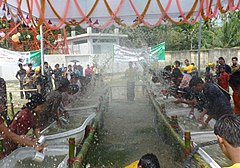| A major contributor to this article appears to have a close connection with its subject. It may require cleanup to comply with Misplaced Pages's content policies, particularly neutral point of view. Please discuss further on the talk page. (February 2022) (Learn how and when to remove this message) |
| ကင် Sangrai সাংগ্রাই | |
|---|---|
 water festival of 'Sangrai' water festival of 'Sangrai' | |
| Official name | Sangrai Festival |
| Also called | Jye Sakroi |
| Observed by | Marma and Rakhine People |
| Liturgical color | Green |
| Type | Cultural, ethnic & Buddhist |
| Significance | Sign of Coming New Year |
| Celebrations | Decorating the house with flowers, lighting candles and praying in Bihar, walking around the neighbor's house. |
| Observances |
|
| Begins | 12 April |
| Ends | 15/16 April |
| Date | 14 April (Main Sangrai) |
| Frequency | Annual |
| First time | 1359; 666 years ago (1359) |
| Related to | Boisabi |
Sangrai (eng.Year changes) is the name of the New Year celebration of the Bangladeshi Marma and Rakhine ethnic groups, which is celebrated from April 13 to 15 every year. Although it is one of the main traditional ceremonies of the Marmas, the Rakhine also celebrate the New Year with their own rules. In the case of the Marmas, it is celebrated according to their Burmese calendar. The calendar of the Marmas is called "Mraima Sakraoy". The Marmaras observe Sangrai as a total of three days, including the last two days of the old year and the first day of the new year. Earlier, according to "Mraima Sacramento", these three days fell in the middle of April of the English calendar, but now they are observed on April 13, 14 and 15 in line with the English calendar. The traditional games of the Marmas are also held on the morning of the 13th with Pangchowai (Flower Sangrai), the main Sangrai on the 14th and the water on the 15th.
Pangchowai (Flower Sangrai)
Absolutely one night of "Paanchowai" is used for worshiping Buddha and decorating houses. Although there are many flowers in the mountains, certain flowers are used to decorate the houses. The most popular of these is the cloud-colored flower called "Sangrai Paing". Everyone mainly decorates their houses on the day after "Paanchhoai" with this flower as the main thing.



Celebration
The work of plucking this flower is mainly done by the Marma youth. On the night of 'Paanchowai', Marma youths organize various events around it. Many people stay up all night making special types of pastries which they call "Pitha", while others arrange various traditional games for the Marmas. Some even arrange traditional Marma dances and songs. Basically, Marma youths use various tactics to stay awake all night. Then, after the arrival of the last night, that is, before dawn, they went to the mountains in groups and picked up 'Sangrai Paing' and handed it over to their mother. Ginnis decorate the flowers with needle and thread in the morning. First, the Buddha is worshiped with flowers and every door of every house is decorated with them. With the flowers arranged on the door of the house, it can be understood that Sangrai i.e. the new year has started.
Not only young people but also young Marma boys and girls are interested in this 'Paanchhoai'. However, taking them to the mountains is very risky, as the elders always prevent the little boys and girls from going to the mountains for fear of the 'Frujuma' (Marma witch). There are even a lot of stories about this "Paanchhoai". The most popular of these is the story of 'Frujuma's Trap'. The Fruzuma witch, in the lure of 'Sangrai Paing', takes one of the children away to a deep forest that will never be released before daybreak. Because after falling into the trap, wherever he goes, he will find only jungle and jungle.
The main attraction of Sangrai is the water sport called Marmara "Ri Long Poye". This water sports festival is held on the last day of Sangrai festival. Sangrai water sports are performed not only by the Marmas, but also by the Dai tribes of Southeast Asia, Myanmar, Thailand, Laos, Cambodia and China in mid-April. In Myanmar, such events are called "Thingyan" and in Thailand and Laos this ceremony is called "Sankran". "Sankran" in Thai means change. Sangrai actually means saying goodbye to the old year and welcoming the new year. At the same time, the new Jhum farming season in the Chittagong Hill Tracts begins after Sangrai. Not only Jhum farming, the Marmaras do not get married again after the Maghi full moon until Sangrai, which means that the Marmaras in Sangrai mean to start anew by throwing away all the old things, including the beginning of the new year. And so the Marmaras celebrate the New Year with a joyous ceremony in the hope of blessings and good wishes.
In this way, apart from playing water officially, everyone has a bottle of water in their hands on that day. He can sprinkle water on whomever he wants, no one objects to it but takes it as a symbol of blessings and good omens.
See also
| Wikimedia Commons has media related to Marma people. |
- Bamar people
- Barua (Bangladesh)
- Bengali Buddhists
- Bizhu, Chakma New Year festival
- Buddhism in Bangladesh
- Madhu Purnima
- Mog people
- Rakhine people
- Songkran
- Thingyan, Burmese New Year festival
References
- সাংগ্রাই. Daily Naya Diganta (in Bengali). Retrieved 2021-10-19.
- ^ "Four-day Sangrai festival begins in Bandarban". The Daily Star. 2014-04-14. Retrieved 2021-10-19.
- "Celebrating Biju, Baisu, Sangrai". New Age. Retrieved 2022-01-17.
- ^ "Sangrai festival spreads wave of festivity in the hills". bdnews24.com. 13 April 2005. Retrieved 2021-10-19.
- ^ "Sangrai water festival of Marma celebrated in Rangamati". Dhaka Tribune. 2018-04-15. Retrieved 2021-10-19.